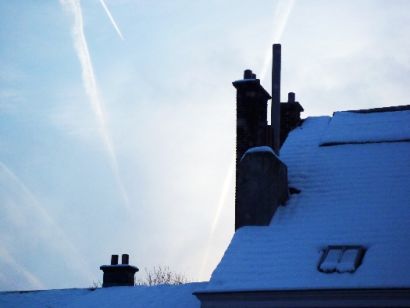
The correct performance of a Stûv fire or stove depends on 5 factors: the product itself, the smoke outlet, the wood, the air supply and whether the product is being used correctly.
First of all, choose an efficient, next-generation wood-burning stove or fire that suits the room you want to heat, where air can be drawn in from the outside to encourage combustion.
Regular maintenance of your fire is essential. As well as an annual sweep, you will need to check the seals that keep the device sealed and make sure that the wood is burning cleanly.

The smoke duct is a vital component for the efficient performance of your fire or stove. The smoke produced by burning wood is very hot, and has a natural propensity to rise. The duct must encourage the flow of smoke.
What makes a good duct?
A duct that creates enough draw, but not too much, for its fireplace.
And what do you need to do to encourage this draw?
adequate height, as straight and vertical a path as possible. Wherever there is a bend or a diversion, the smoke slows down and cools.
a smooth surface that doesn’t disrupt the flow of the smoke and means that any unburned particles don’t stick to it.
a consistent, suitable shape, preferably round rather than square, and in principle, never smaller than the diameter of the smoke outlet,
a thermally insulated duct: if the smoke cools down, it loses its ability to rise and may condense (the steam in the smoke becomes liquid and forms droplets inside the duct); a duct that passes through unheated areas (an attic) or is installed outdoors must be insulated,
a chimney fitted with a good cover that maintains the right amount of draw, whatever the direction or strength of the wind.
The dimensions of the chimney will be decided by your fitter.
The chimney must be swept regularly (at least once a year).

If possible, use hardwood
As they burn, hardwoods (oak, beech, ash, hornbeam and fruit trees) produce a lovely flame and glowing embers that last for longer. Do not use wood from conifers: they burn hot but quickly, with lots of sparks, and their resin makes chimneys dirty. Wood that has undergone chemical treatments, such as telephone poles and chipboard panels, are prohibited as they produce harmful smoke.
The wood needs to be nice and dry
This is obvious: as damp wood burns, it produces lots of smoke and not many flames, as well as making the fireplace, glass and chimney dirty. If possible, use wood that has been chopped and stored in a well aired, sheltered place. The wood needs to dry for around two years after being chopped before it should be used for burning. The dryer it is - in other words, if its humidity is below 20% - the lighter it is, and the higher pitched the sound is when the logs bang together.

Burning wood uses air (you need 8m³ of air to burn 1kg of wood). In traditional homes, the replacement air required comes in under doors or through window frames. In more modern buildings, which are well sealed, you will need an air inlet directly connected to the fire. You will also need to take into account other elements that use up air, such as an oven hood (extractor hood) or a ventilation system that may disrupt the performance of the fire or stove (expelling smoke into the house, risk of the fire going out). Consider discussing these elements with your fitter when you start to plan your project. They will help you find the right solution for you.
The most important partner for your projects: your Stûv dealer!
In order to give you an accurate assessment of your smoke duct, advise you on your choice of Stûv product, suggest original integration solutions, or tell you about any premiums or tax deductions offered in some countries or regions of Europe, your Stûv dealer is the person with the knowledge and experience you can trust. Talk to them as early as possible in your building or renovation projects. You will find the list of dealers near your home on the Points of Sale page.
To get the most out of your wood-burning stove, you will have to use it at its highest setting, in other words, at a high temperature, with logs covering the whole width of the base of the burner.
This is when it becomes more economical and ecological: it produces more heat and less waste. So it is important to choose the right size of fire, to make sure it doesn’t overheat the room it is in.
Conclusion: your fire should always burn with lots of flames.
The way you light your fire also has a very important impact on the cycle of heat. Make sure there is enough wood, kindling and firelighter to heat the duct and start to draw air down the chimney. We recommend the top-down method of lighting fires. See your instructions book.
.